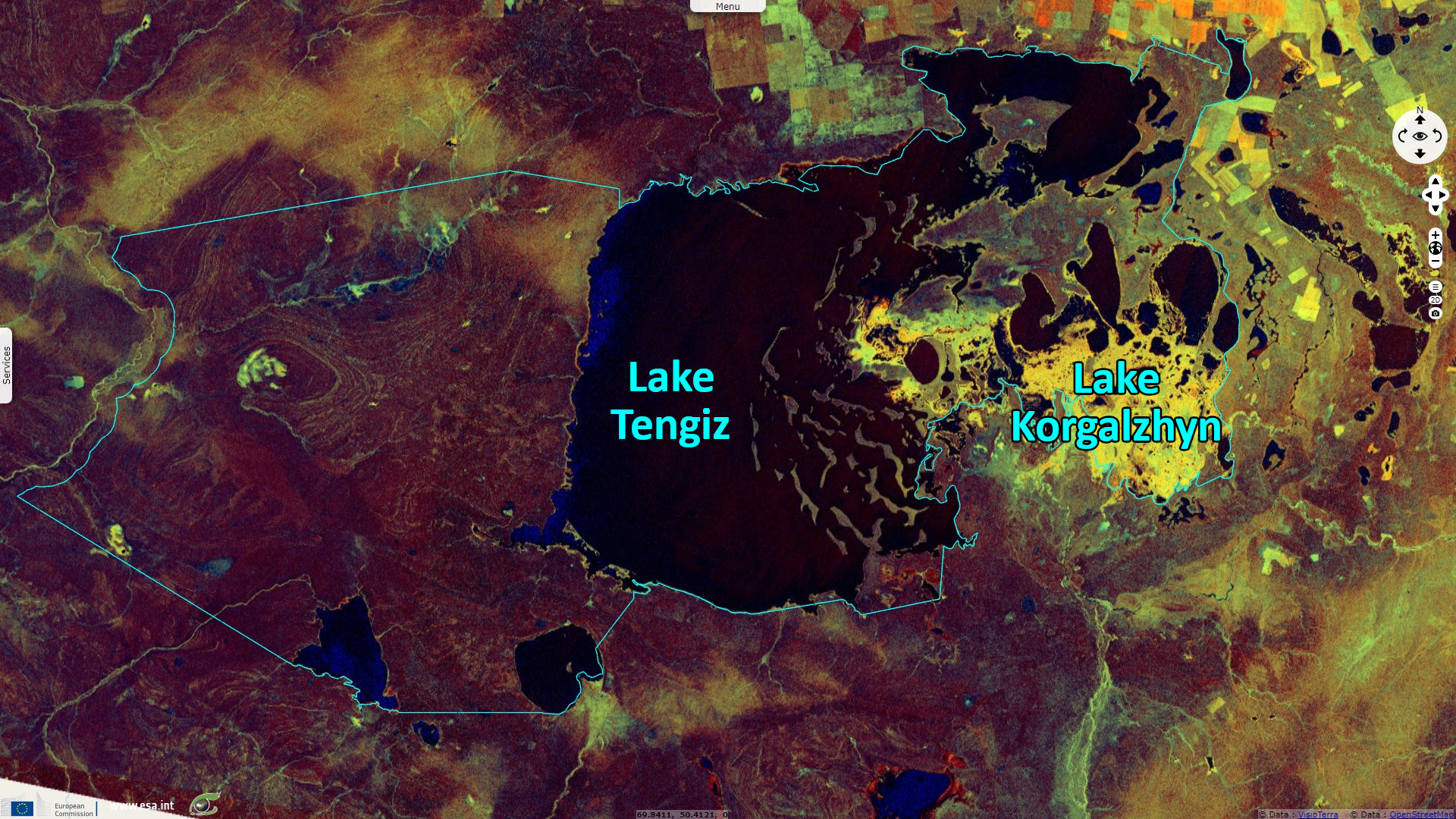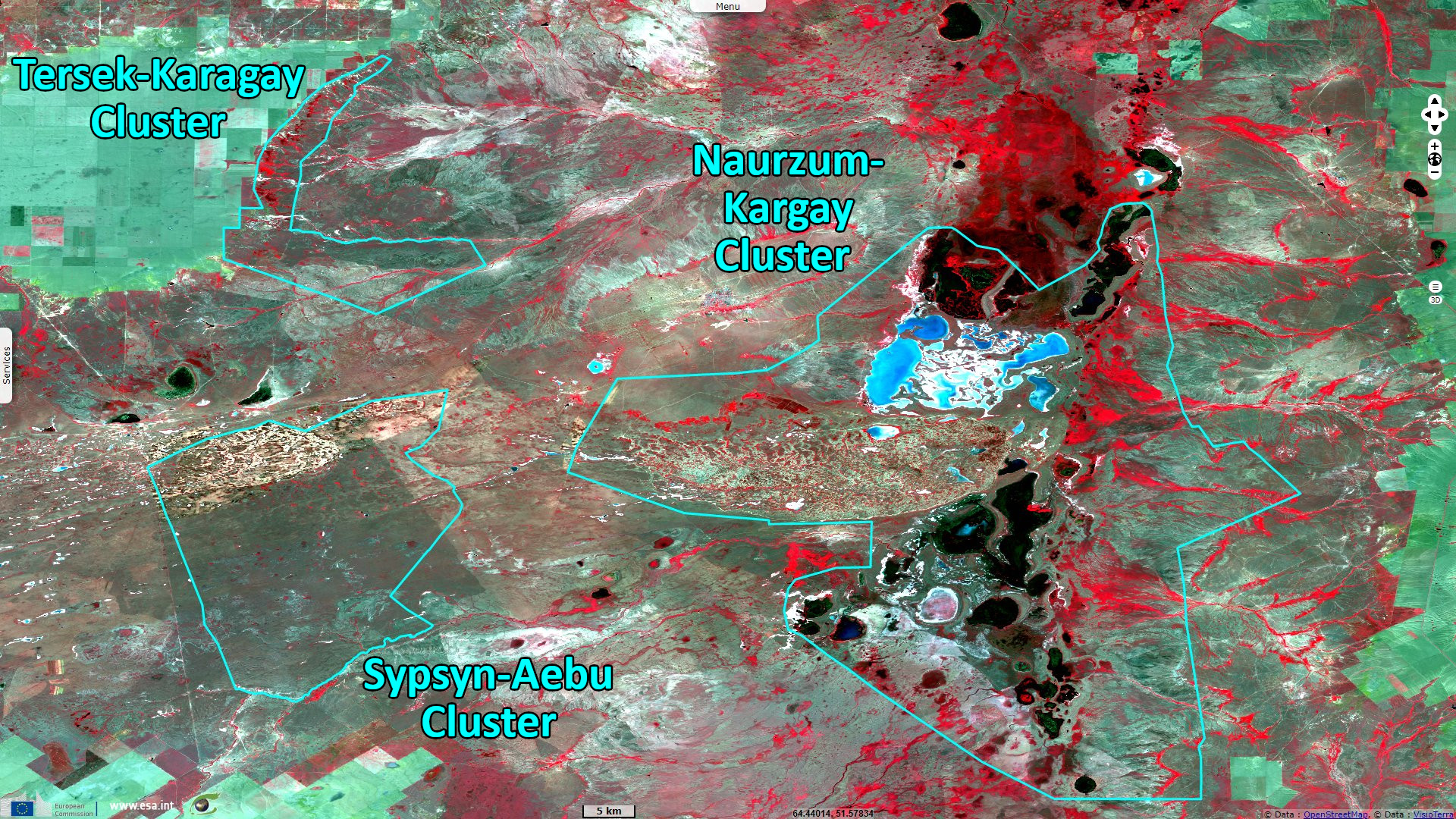Saryarka steppe and lakes in northern Kazakhstan, a key stopover for migratory birds
Sentinel-1 CSAR IW acquired on 02 June 2021 from 01:50:54 to 01:51:19 UTC
...
Sentinel-2 MSI acquired on 15 October 2021 at 06:48:39 UTC
Sentinel-2 MSI acquired on 27 April 2023 at 06:26:31 UTC
Sentinel-3 OLCI FR & SLSTR RBT acquired on 30 April 2023 at 06:08:20 UTC
...
Sentinel-2 MSI acquired on 15 October 2021 at 06:48:39 UTC
Sentinel-2 MSI acquired on 27 April 2023 at 06:26:31 UTC
Sentinel-3 OLCI FR & SLSTR RBT acquired on 30 April 2023 at 06:08:20 UTC
Keyword(s): UNESCO World Heritage site, UNESCO biosphere reserve, RAMSAR wetland, steppe, salt lake, biodiversity, Kazakhstan
Saryarka Steppe and Lakes of Northern Kazakhstan comprises two protected areas: Korgalzhyn State Nature Reserve and Naurzum State Nature Reserve totalling 450,344 ha. The first area is protected as a UNESCO biosphere reserve: "Korgalzhyn was Kazakhstan’s first biosphere reserve. Situated in the north central part of Kazakhstan, the site is a complex of freshwater and saline lakes embedded in the dry steppe zone of Eurasia. Environmental degradation caused by previously unsustainable management practices are now being addressed through a number of pilot projects. The territory is characterized by elevated plains, hills, lake depressions and marked by an extreme-continental climate."
It is also a RAMSAR wetland with little relief and grass oceans covering the land to the horizon. Reed beds scattered on islands by the heavy ice load of the winter leave channels and lakes open. The Tengiz-Korgalzhyn lakes have been a strict nature reserve since 1968, but the adjacent lake systems of the Tengiz lake basin are not strictly protected and will be added as clusters to this nomination at a later stage.
"These wetlands are key stopover points and crossroads on the Central Asian flyway of birds from Africa, Europe and South Asia to their breeding places in Western and Eastern Siberia. The 200,000 ha Central Asian steppe areas included in the property provide a valuable refuge for over half the species of the region’s steppe flora, a number of threatened bird species and the critically endangered Saiga antelope, formerly an abundant species much reduced by poaching." says its UNESCO World Heritage webpage.
The biodiversity of this UNESCO biosphere reserve: "includes more than 500 species of plants and more than 1400 species of water and terrestrial animals, consisting of 42 mammal species, 14 fish species and 344 bird species. Water birds of Tengiz-Korgalzhyn lakes include 112 species, which is 87% of the total water bird fauna of Kazakhstan. To the present date more than 700 species of insects have been recorded here, although their species diversity may reach more than 3000 species."
"Potential fodder reserves of only one Tengiz lake are able to provide food for 15 million birds. The most Northern nesting population of Flamingo is located here; its population in some years may reach 50,000-60,000 birds."
RAMSAR adds: "The Korgalzhyn Lakes harbor big colonies of the Dalmatian Pelican with over 500 breeding pairs nesting in the vast reed beds (10% of the world population). The White-headed Duck is breeding and resting at the fresh and brackish lakes; in autumn it can be observed in numbers of up to 4,000 birds (30-40% of the world population) in the protected area." The Biosphere Reserve also includes globally threatened species, among them the extremely rare Steppe Eagle, Pallid Harrier, Pallas’s Sand grouse, Demoiselle Crane, Great and Little Bustard.
The second protected area is Naurzum Lake System, made of "A system of approximately 26 lakes in northern Kazakhstan and a near natural example of an Asian steppes-region wetland with outstanding importance for birds. The Lakes' cyclic hydrologic regime provides seasonal and annual diversity of fresh to saline habitats, including for the Critically Endangered Siberian Crane and 23 other threatened species, notably significant percentages of Lesser White-fronted Goose and Red-breasted Goose populations.", indicates its RAMSAR sheet.
"It is a site of mass moulting for ducks and swans, nesting for 158 species, and an important stop for hundreds of thousands of migratory birds. It regularly supports more than 1% of 20 species of waterbirds. Flooding on average every 12-15 years, the Lake System is important for sustaining groundwater levels in the region.".











